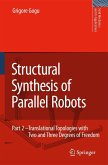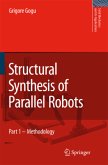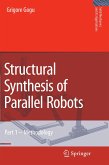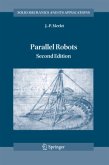This book represents the second part of a larger work dedicated to the structural synthesis of parallel robots.
The originality of this work resides in the fact that it combines new formulae for mobility connectivity, redundancy and overconstraint, and the evolutionary morphology in a unified approach of structural synthesis giving interesting innovative solutions for parallel robotic manipulators. This is the first book of robotics presenting solutions of coupled, decoupled, uncoupled, fully-isotropic and maximally regular translational parallel robotic manipulators systematically generated by using the structural synthesis approach proposed in Part 1. Non-redundant/redundant, overconstrained/isostatic solutions with simple/complex limbs actuated by linear/rotary actuators with/without idle mobilities are proposed. Many solutions are presented here for the first time in the literature.
The author had to make a difficult and challenging choice between protecting these solutions through patents, and releasing them directly into the public domain. The second option was adopted by publishing them in various recent scientific publications and mainly in this book. In this way, the author hopes to contribute to a rapid and widespread implementation of these solutions in future industrial products.
"The mathematical investigations referred to bring the whole apparatus of a great science to the examination of the properties of a given mechanism, and have accumulated in this direction rich material, of enduring and increasing value. What is left unexamined is however the other, immensely deeper part of the problem, the question: How did the mechanism, or the elements of which it is composed, originate? What laws govern its building up? Is it indeed formed according to any laws whatever? Or have we simply to accept as data what invention gives us, the analysis of what is thus obtained being the only scientific problem left - as in the case of natural history?" Reuleaux, F., Theoretische Kinematik, Braunschweig: Vieweg, 1875 Reuleaux, F., The Kinematics of Machinery, London: Macmillan, 1876 and New York: Dover, 1963 (translated by A.B.W. Kennedy) This book represents the second part of a larger work dedicated to the structural synthesis of parallel robots. Part 1 already published in 2008 (Gogu 2008a) has presented the methodology proposed for structural synthesis. This book focuses on various topologies of translational parallel robots systematically generated by using the structural synthesis approach proposed in Part 1. The originality of this work resides in the fact that it combines the new formulae for mobility connectivity, redundancy and overconstraints, and the evolutionary morphology in a unified approach of structural synthesis giving interesting innovative solutions for parallel mechanisms.
The originality of this work resides in the fact that it combines new formulae for mobility connectivity, redundancy and overconstraint, and the evolutionary morphology in a unified approach of structural synthesis giving interesting innovative solutions for parallel robotic manipulators. This is the first book of robotics presenting solutions of coupled, decoupled, uncoupled, fully-isotropic and maximally regular translational parallel robotic manipulators systematically generated by using the structural synthesis approach proposed in Part 1. Non-redundant/redundant, overconstrained/isostatic solutions with simple/complex limbs actuated by linear/rotary actuators with/without idle mobilities are proposed. Many solutions are presented here for the first time in the literature.
The author had to make a difficult and challenging choice between protecting these solutions through patents, and releasing them directly into the public domain. The second option was adopted by publishing them in various recent scientific publications and mainly in this book. In this way, the author hopes to contribute to a rapid and widespread implementation of these solutions in future industrial products.
"The mathematical investigations referred to bring the whole apparatus of a great science to the examination of the properties of a given mechanism, and have accumulated in this direction rich material, of enduring and increasing value. What is left unexamined is however the other, immensely deeper part of the problem, the question: How did the mechanism, or the elements of which it is composed, originate? What laws govern its building up? Is it indeed formed according to any laws whatever? Or have we simply to accept as data what invention gives us, the analysis of what is thus obtained being the only scientific problem left - as in the case of natural history?" Reuleaux, F., Theoretische Kinematik, Braunschweig: Vieweg, 1875 Reuleaux, F., The Kinematics of Machinery, London: Macmillan, 1876 and New York: Dover, 1963 (translated by A.B.W. Kennedy) This book represents the second part of a larger work dedicated to the structural synthesis of parallel robots. Part 1 already published in 2008 (Gogu 2008a) has presented the methodology proposed for structural synthesis. This book focuses on various topologies of translational parallel robots systematically generated by using the structural synthesis approach proposed in Part 1. The originality of this work resides in the fact that it combines the new formulae for mobility connectivity, redundancy and overconstraints, and the evolutionary morphology in a unified approach of structural synthesis giving interesting innovative solutions for parallel mechanisms.
From the reviews: "Part 2 begins with a short summary of developed by the author new formulae for mobility, connectivity, redundancy, and over-constraint. ... Parallel robotic manipulators can be considered a well-established ... subject of many robotic research studies. ... the author has made a significant contribution towards establishing innovative and interesting solutions for parallel mechanisms. ... The presentation is at a level of a graduate textbook, and the book will be useful and enjoyed by serious graduate students and by scientists and engineers from academia and industry." (Franz Selig, Zentralblatt MATH, Vol. 1168, 2009)









